Chapter 14.48
DENSITY AND DIMENSIONAL REGULATIONS
Sections:
14.48.010 Minimum Lot Size Requirements
14.48.040 Building Setback Requirements
14.48.045 Accessory Structures
14.48.050 Exceptions to Building Setback Requirements
14.48.060 Building Height Limitations
14.48.085 Density Calculation and Lot Size Averaging
14.48.090 Density on Lots Where Portion Dedicated to City for Park and Recreational Facilities
14.48.094 Minimum Lot Size on Lots Where Right-of-Way is Dedicated to the City
14.48.010 Minimum Lot Size Requirements.
Table 14.48-I indicates the basic minimum lot size required for each zone district, which shall apply to all created lots unless a reduction is otherwise allowed pursuant to a specific regulation contained elsewhere in this title. (Ord. 811, Sec. 55, 2010; Ord. 676, Sec. 43, 2003; Ord. 590, 1998; Ord. 468, 1995)
14.48.020 Duplexes in Single-Family Zones.
Repealed by Ord. 1179. (Ord. 1080, Sec. 8, 2020; Ord. 1030, Sec. 2 (Exh. B), 2018; Ord. 676, Sec. 44, 2003; Ord. 590, 1998; Ord. 468, 1995)
14.48.030 Minimum Lot Widths.
(a) No lot may be created that is so narrow or otherwise so irregularly shaped that it would be impracticable to construct on it a building that:
(1) Could be used for purposes that are permissible in that zoning district; and
(2) Could satisfy any applicable setback requirements for that district.
(b) Without limiting the generality of the foregoing standard, Table 14.48-I establishes minimum lot widths. The lot width shall be measured along a horizontal line between side lot lines measured at approximate right angles at the midway point between the front and rear lot lines.
(c) No lot created after the effective date of this title that is less than the recommended width shall be entitled to a variance from any building setback requirement. (Ord. 1080, Sec. 8, 2020; Ord. 468, 1995)
14.48.035 Lot standards.
(a) Corner lots situated at the intersection of two or more streets shall measure the front setback along the lot line abutting the right-of-way that best conforms to the pattern of existing site development on adjacent lots. Side setbacks along side streets are reduced to 10 feet.
(b) Interior lots shall measure the front setback along the lot line abutting the right-of-way.
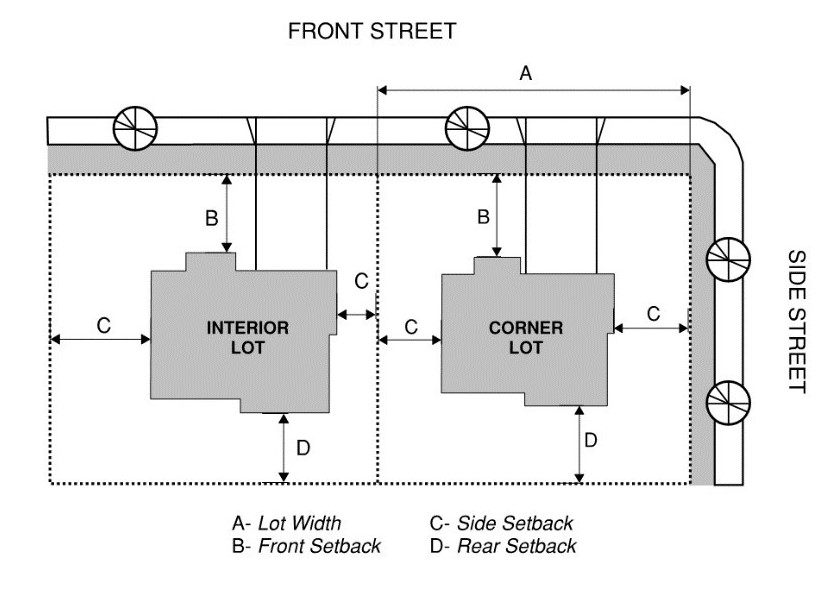
(c) Panhandle/flag lots are lots accessed from the abutting right-of-way by a narrow access corridor of land within the same lot. Panhandle lots shall be allowed subject to the following requirements:
(1) Panhandle lots shall meet setback and other dimensional standards, on the portion of the lot outside the panhandle, where the access corridor joins the wide portion of the lot. The area within the panhandle access corridor shall not be used to determine lot area, lot width, lot depth or impervious area for the lot.
(2) The panhandle shall provide direct access to a paved public or private street. The access corridor shall maintain a minimum width of 15 feet, a minimum height clearance of 12 feet and meet the City’s engineering standards.
(3) There shall not be more than two contiguous panhandle lots where the panhandles abut. In such cases the panhandles can be reduced to 10 feet per lot.
(4) All requirements of the fire code shall be met, including access, turnarounds and sprinklers as applicable.
(5) No buildings shall be erected within the panhandle access.
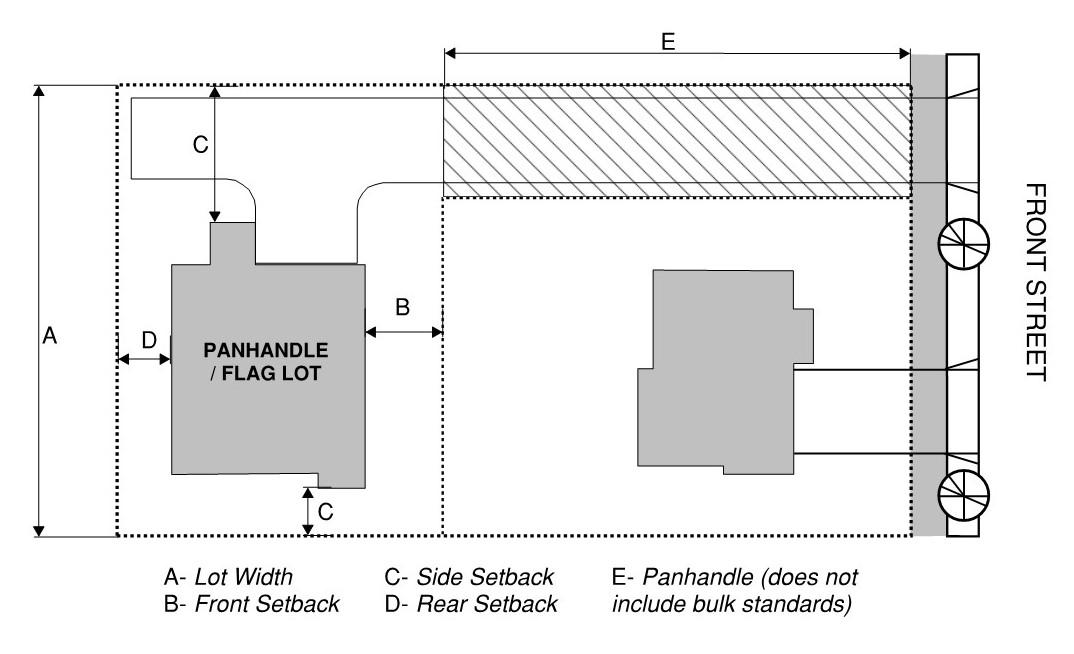
Typical configuration for panhandle lot. Setbacks and orientation can vary based on site conditions.
(d) Through lots including lots with parallel or approximately parallel streets shall measure the front setback along the lot line abutting the right-of-way that best conforms to the pattern of existing site development on adjacent lots or that lot line which abuts a nonarterial street. The other lot line abutting a right-of-way shall be considered a rear yard.
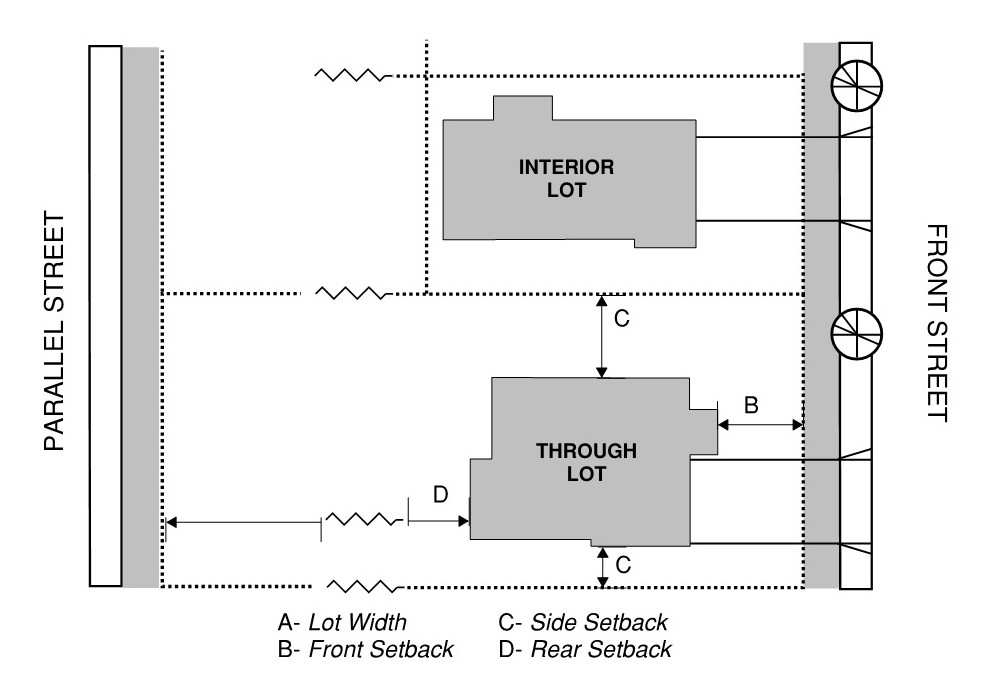
(Ord. 1080, Sec. 8, 2020)
14.48.040 Building Setback Requirements.
(a) Table 14.48-I and Table 14.48-II set forth the minimum building and freestanding sign setbacks required from lot lines.
(1) Setbacks from access easements and access tracts are considered lot line setbacks for the purpose of determining front setbacks.
(2) As used in this section, the term “building” includes any substantial structure which by nature of its size, scale, dimensions, bulk, or use tends to constitute a visual obstruction or generate activity similar to that usually associated with a building. It also includes any element that is substantially a part of the building, such as bay windows and chimneys, and not a mere appendage, such as a flagpole. Without limiting the generality of the foregoing, for the purpose of determining setbacks the following structures are to be considered buildings:
(i) Gas pumps and overhead canopies or roofs;
(ii) Fences, walls, and hedges (see Chapter 14.52 for height and setback requirements).
(b) Whenever a lot in a residential district abuts a nonresidential district, and its required setback is greater than that of the nonresidential lot, the nonresidentially zoned lot shall observe the more restrictive setback. Where a lot zoned General or Light Industrial shares a boundary with a residentially zoned lot, the setback for the industrial property along that common boundary shall be 30 feet.
(c) All docks and other permissible overwater structures shall be set back pursuant to the Shoreline Master Program, Chapter 4, Section C.3. For the purposes of this section each property line extending into the lake shall be construed as extending at the same angle as the property line on shore. (Ord. 1080, Sec. 8, 2020; Ord. 1063, Sec. 2 (Exh. B), 2019; Ord. 903, Sec. 38, 2013; Ord. 898, Sec. 7, 2013; Ord. 796, Sec. 8, 2009; Ord 666, Sec. 8, 2002; Ord. 612, Sec. 1, 1999; Ord. 590, 1998; Ord. 468, 1995)
14.48.045 Accessory Structures.
(a) In single-family residential zones, accessory structures must meet the following conditions:
(1) The gross floor area of all accessory structures shall not exceed 200 square feet without a building permit;
(2) The height of the accessory structure shall not exceed 12 feet without a building permit; and
(3) The accessory structure may be set back five feet from rear and side property lines but shall be no closer to the front property line than the front setback of the underlying zoning district. Accessory dwelling units shall adhere to the setbacks of the underlying zoning district unless otherwise permitted or authorized in Section 14.44.045. (Ord. 1179, Sec. 14, 2024; Ord. 1080, Sec. 8, 2020)
14.48.050 Exceptions to Building Setback Requirements.
(a) The following modifications to the setback requirements identified in Section 14.48.040 shall be allowed:
(1) In all single-family residential zones, the building setbacks from the street of the underlying zone may be reduced by five feet for living portions of the principal house or open porches. This reduction does not apply to garages or carports.
(2) Exterior mechanical equipment including air conditioners, heat pumps and similar may extend up to 32 inches into the required side setback provided emergency access is not impaired.
(3) Eaves and other minor architectural features may project into the required setback up to 18 inches. (Ord. 1080, Sec. 8, 2020; Ord. 1063, Sec. 2 (Exh. B), 2019; Ord. 903, Sec. 39, 2013; Ord. 811, Sec. 56, 2010; Ord. 741, Sec. 7, 2007; Ord. 676, Sec. 45, 2003; Ord. 666, Sec. 9, 2002; Ord. 595, 1999; Ord. 468, 1995)
14.48.055 Maximum Impervious Surface.
Repealed by Ord. 1080. (Ord. 1069 § 7, 2020; Ord. 947, Sec. 2, 2015; Ord. 595, 1999)
14.48.060 Building Height Limitations.
(a) For purposes of this section the height of a building shall be the vertical distance measured from the mean elevation of the finished grade along four points of the proposed building to the highest point of the building. The height of fences, walls, and hedges is as set forth in Chapter 14.52. The average finished grade shall be determined by first delineating the smallest square or rectangle which can enclose the building and then averaging the ground elevations taken at the midpoint of each side of the square or rectangle.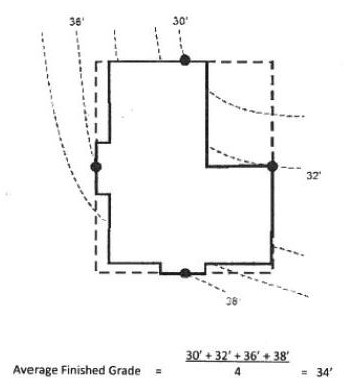
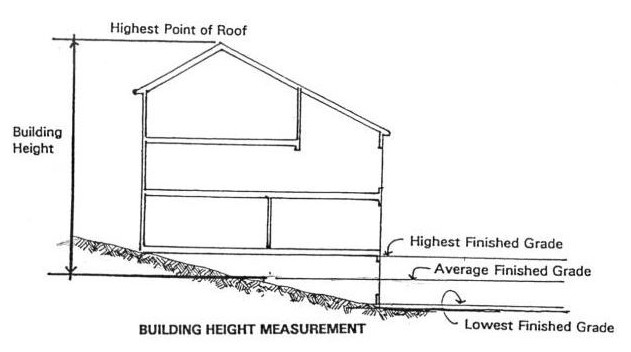
(b) Building height limitations in the various zoning districts shall be as listed in Table 14.48-I and Table 14.48-II.
(c) The following features are exempt from the district height limitations set forth in subsection (b) of this section, provided they conform to the standards contained in subsection (d) of this section:
(1) Chimneys, church spires, elevator shafts, and similar structural appendages not intended as places of occupancy or storage;
(2) Flagpoles and similar devices;
(3) Heating and air conditioning equipment, solar collectors, and similar equipment, fixtures, and devices.
(d) The features listed in subsection (c) of this section are exempt from the height limitations set forth in subsection (b) of this section if they conform to the following requirements:
(1) Not more than one-third of the total roof area may be consumed by such features.
(2) The features described in subsection (c)(3) of this section must be set back from the edge of the roof a minimum distance of one foot for every foot by which such features extend above the roof surface of the principal building to which they are attached.
(3) The permit-issuing authority may authorize or require that parapet walls be constructed (up to a height not exceeding that of the features screened) to shield the features listed in subsections (c)(1) and (3) of this section from view.
(e) Towers and antennas which exceed the height limit of the zone district are allowed to the extent authorized in the Table of Permissible Uses, use classification 18.000. (Ord. 1080, Sec. 8, 2020; Ord. 1063, Sec. 2 (Exh. B), 2019; Ord. 676, Sec. 46, 2003; Ord. 590, 1998; Ord. 468, 1995)
14.48.070 Cluster Subdivisions.
Repealed by Ord. 1069. (Ord. 903, Sec. 40, 2013; Ord. 501, Sec. 10, 1995; Ord. 468, 1995)
14.48.080 Architecturally Integrated Subdivisions.
Repealed by Ordinance 579.
14.48.085 Density Calculation and Lot Size Averaging.
(a) The density calculation for new residential developments and subdivisions shall be based on an adjusted gross density as follows, unless otherwise defined in this title:
(1) Subtract the actual percentage of the area devoted to infrastructure and other encumbrances including but not limited to streets and stormwater, existing easements, utility corridors, etc., from the gross development area up to 25 percent of the gross development area to determine the net buildable area.
(2) Divide the net buildable area by the minimum lot size of the underlying zoning district to determine the maximum adjusted gross density.
(3) For the multifamily residential zoning district, the minimum density is 15 units per acre. The maximum density will be limited by bulk standards, maximum height, required open space, parking and other zoning standards of this title.
(4) Limitations. Nothing contained within this chapter guarantees the maximum adjusted gross density will be attained. The adjusted gross density may not always be achievable due to unique site considerations including, but not limited to, critical areas, topography, right-of-way dedications, utility easements, open space requirements and stormwater requirements.
(5) When the adjusted gross density is determined, if the calculation for lots or units results in a fraction of 0.5 or greater the number shall be rounded up to the next whole number.
(b) Lot Size Averaging. After calculating the adjusted gross density, the proponent may apply limited lot size averaging provisions up to the amount necessary to achieve the adjusted gross density. The proponent may use one of the following methods, unless dimensional standards are modified by other sections of this title, including but not limited to planned residential developments, cluster subdivisions and infill development:
(1) The proponent may reduce lot sizes by 10 percent within the residential development and/or subdivision provided no other dimensional reductions are applied; or
(2) The proponent may reduce lot widths within the residential development and/or subdivision by 10 percent. In no case shall lots be less than 40 feet wide provided no lot size reductions are applied. (Ord. 1080, Sec. 8, 2020)
14.48.090 Density on Lots Where Portion Dedicated to City for Park and Recreational Facilities.
(a) Subject to the other provisions of this section, if (1) any portion of a tract lies within an area designated on any officially adopted City plan as part of a proposed public park, greenway, or bikeway, and (2) before the tract is developed, the owner of the tract, with the concurrence of the City, dedicates to the City that portion of the tract so designated, then, when the remainder of the tract is developed for residential purposes, the permissible density at which the remainder may be developed shall be calculated in accordance with the provisions of this section.
(b) If the proposed use of the remainder is a single-family detached residential subdivision, then the lot size in such subdivision may be reduced in accordance with the provisions of Sections 14.48.070 except that the developer need not set aside usable open space to the extent that an equivalent amount of land has previously been dedicated to the City in accordance with subsection (a) of this section.
(c) If the proposed use of the remainder is a two-family or multifamily project, then the permissible density at which the remainder may be developed shall be calculated by regarding the dedicated portion of the original lot as if it were still part of the lot proposed for development.
(d) If the portion of the tract that remains after dedication as provided in subsection (a) of this section is divided in such a way that the resultant parcels are intended for future subdivision or development, then each of the resultant parcels shall be entitled to its pro rata share of the “density bonus” provided for in subsections (b) and (c) of this section. (Ord. 590, 1998; Ord. 468, 1995)
14.48.094 Minimum Lot Size on Lots Where Right-of-Way is Dedicated to the City.
Where land is dedicated to the City for public rights-of-way for a short plat or a building permit for a single-family house or a duplex, the minimum parcel size may be reduced by an equivalent square footage as that dedicated, not to exceed 10 percent of the required minimum parcel size. (Ord. 590, 1998; Ord. 468, 1995)
14.48.100 Rural Subdivisions.
Repealed by Ord. 1080. (Ord. 468, 1995)
|
Zoning District |
Lot Size |
Lot Width |
Front Setback3 |
Side Setback10 |
Rear Setback |
Maximum Impervious Area7 |
Maximum Height |
|
|---|---|---|---|---|---|---|---|---|
|
R4 |
8,000 sq ft |
60 feet internal 65 feet corner |
25 feet |
15 total (no less than 5 feet one side) |
20 feet |
50% |
35 feet |
|
|
WR |
9,600 sq ft |
variable - not less than 50 feet |
25 feet |
15 total (no less than 5 feet one side) |
20 feet8 |
40%6 |
35 feet |
|
|
R6 |
6,000 sq ft |
50 feet internal 55 feet corner |
20 feet |
10 total (no less than 5 feet one side) |
15 feet |
55% |
35 feet |
|
|
R8-124 |
Detached |
4,000 sq ft |
45 feet internal 50 feet corner |
15 feet (25 feet max.)9 |
10 total (no less than 5 feet one side) |
10 feet |
65% |
35 feet |
|
Attached |
2,800 sq ft |
16 feet internal 26 feet corner |
15 feet (25 feet max.)9 |
10 feet between other districts or buildings on site |
10 feet |
75% |
45 feet |
|
|
MFR |
None |
20 feet5 |
Variable |
10 feet between other districts or buildings on site |
10 feet between other districts |
80% |
55 feet |
|
Notes:
1. Unless otherwise stated, the dimensional standards refer to minimum requirements.
2. See Chapter 14.46, Part III, for density standards for middle and infill housing.
3. The minimum required setback for garages is 20 feet from the front lot line to ensure sufficient space for cars to park in driveways without blocking sidewalks.
4. The R8-12 zoning district applies two sets of development standards depending on if the project is a detached single-family or attached townhouse development. Developments may apply a mix of standards if both types of housing are represented in the project up to the maximum adjusted gross density. For attached units, the 2,800 square foot lot size is not a minimum lot size and is instead used to determine adjusted gross density per Section 14.48.085.
5. Twenty-foot minimum street frontage.
6. Per Lake Stevens Shoreline Master Program.
7. The allowance for maximum impervious surfaces shall apply to new subdivisions, short subdivisions, infill development and multifamily developments on parcels with adequate stormwater facilities developed under the current Washington State Department of Ecology Stormwater Management Manual for Western Washington or hereafter revised. The lot coverage for lots or developments created prior to 2020 shall be 40 percent for single-family zones (R4, R6 and WR), 65 percent for the R8-12 zoning district and 80 percent for multifamily developments. Any applicant requesting an increase in impervious surfaces to current standards, on existing developed parcels, shall demonstrate that the cumulative increase of impervious surfaces will not impact the overall capacity of the existing stormwater system or the increase in impervious surface cannot be mitigated including the cumulative impervious surface for the entire subdivision or development project as developed.
8. The Lake Stevens Shoreline Master Program requires a 50-foot buffer from the lake and 10-foot setback. On Waterfront Residential parcels separated from the lake by roads the rear (upland) setback is 20 feet; otherwise, rear setbacks from the water will be per the Lake Stevens Shoreline Master Program.
9. The maximum driveway length is mandatory for standard platted lots. Exceptions to this standard may be considered on a case basis for infill lots and lots with unique site conditions including but not limited to critical areas, topography and location of easements and utility corridors.
10. Per Section 14.48.035(a), side setbacks are 10 feet along side streets of corner lots.
|
Zoning District |
Minimum Street Frontage8 |
Front Setback |
Side Setback2,3 |
Rear Setback3 |
Min. Landscape Buffer (ft)3 |
Height4,5 |
|---|---|---|---|---|---|---|
|
Commercial Zones6 |
||||||
|
Business District |
20 |
5 |
10 |
10 |
5 |
55 |
|
Central Business District |
20 |
5 |
10 |
10 |
5 |
55 |
|
Commercial District |
20 |
5 |
10 |
10 |
5 |
55 |
|
Local Business |
20 |
5 |
10 |
10 |
5 |
45 |
|
Planned Business District7 |
20 |
10 |
10 |
10 |
5 |
45 |
|
Public/Semi-Public |
20 |
5 |
10 |
10 |
5 |
55 |
|
Industrial Zones6 |
||||||
|
Light Industrial |
20 |
20 |
10 |
10 |
5 |
45 |
|
General Industrial |
20 |
20 |
10 |
10 |
5 |
55 |
|
Mixed Use Zones |
||||||
|
Mixed Use |
20 |
10 |
10 |
10 |
5 |
55 |
|
Mixed Use Neighborhood |
20 |
10 |
10 |
10 |
5 |
45 |
Notes:
1. Districts that allow commercial uses shall maintain a 10-foot, Type B screen when adjacent to residential zones, per Section 14.76.040(a).
2. Attached housing units or attached commercial structures built on separate lots can be built to the common property line. The outside setback for attached structures abutting a right-of-way, separate detached structures, or a different zone shall be 10 feet.
3. Landscape buffers will be comprised of a Type C screen per Section 14.76.040 next to side and rear property lines; however, the City may waive the landscape buffer when adjacent properties share parking, access, or other common features that make intensive landscaping impractical. In addition, perimeter landscape buffer next to property lines of adjacent high-density single-family lots is not required; however, screening different developments from neighboring properties will provide separation, vegetation and define each development.
4. Structures 35 feet or taller next to single-family districts must be stepped back five feet for every floor over 35 feet.
5. The minimum first floor height in Commercial and Mixed Use zoning districts is 15 feet; however, residential structures in Mixed Use districts, without an attached retail/service component, not facing a public right-of-way may be reduced to industry standard.
6. The City will consider an increase in maximum height up to 80 feet with a conditional use permit per Section 14.16C.045.
7. Development standards are found in Section 14.44.090, Planned Business District.
8. Minimum street frontage refers to having either a direct physical connection to a street or right-of-way; or access is provided through an easement.
(Ord. 1179, Sec. 14, 2024; Ord. 1080, Sec. 8, 2020; Ord. 1069 § 7, 2020; Ord. 903, Sec. 38, 2013; Ord. 855, Sec. 22, 2011; Ord. 811, Sec. 55, 2010; Ord. 796, Sec. 9 (Exh. 1), 2009; Ord. 773, Sec. 3, 2008; Ord. 744, Sec. 3, 2007; Ord. 676, Sec. 47, 2003; Ord. 468, 1995)


